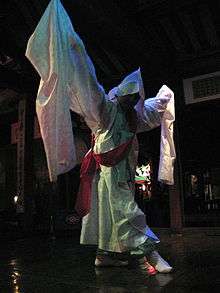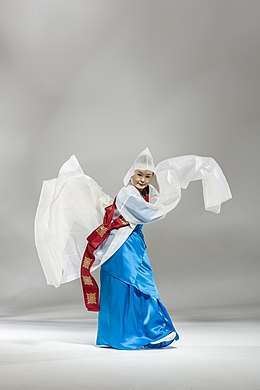Seungmu
Seungmu is a Korean dance performed by Buddhist monks. It is one of the most famous Korean traditional dances and designated as South Korea's important intangible cultural asset number 27 in 1969. It has been developed into a solo dance by professional dancers.
| Seungmu | |
 | |
| Korean name | |
|---|---|
| Hangul | 승무 |
| Hanja | 僧舞 |
| Revised Romanization | Seungmu |
| McCune–Reischauer | Sŭngmu |

Origins
There is little extant evidence regarding how Seungmu was created. Based on analyses of forms and movements of Seungmu, some researchers have suggested that it may derived from other Buddhist ritual dances or ethnic or folk dances.[1] Some said that Seungmu came from bubgo dance, a Buddhist ritual dance. It was once prohibited during the Joseon dynasty era, and then it was transformed into a folk dance and developed mostly by kisaengs.
Forms
The dancer wears a robe (jangsam) with long sleeve called gasa and white hood called (gokkal).[2] The drum or bubgo is the most important part of Seungmu.
The seungmu integrates the eight rhythmic cycles: yeombul, dodeuri, taryeong, jajin taryeong, gutgeori, dwit gutgeori, gujeong nori, and saesanjo. Every now and then, when one rhythm shifts to another, the dancer changes the mood by changing his steps.[3]
Aesthetic
Some regard Seungmu as the most beautiful Korean dance, for the mixture of flowing movements and stillness. The dancer's long and white sleeves movements, the serenity of white hood, a breathtaking pause, and then a soul-stirring movement contribute to the singular uniqueness of the seungmu.[3]
Famous performers
As with many of Korea's Intangible National Treasures, Seungmoo has been preserved by Human Cultural Treasures. The performers themselves are considered Intangible National Treasures of Korea. Until recently, this dance was preserved by Master Lee Mae Bang, who died in 2015.[4] Currently the position for next Human Cultural Treasure has yet to be decided by the Korean Government.
- Lee Mae Bang, National Human Treasure, for Intangible Cultural Asset No. 27 and 97.
- Kim Myo Seon, Master Assistant of Intangible Cultural Asset No. 27.
- Kim Myung Ja, Master Assistant of Intangible Cultural Asset No. 27.
- Han Young-suk, Master of Korean Dance from 1969, including seungmu.
See also
- Korean culture
- Korean Buddhism
- Korean Buddhist temple
References
- Seungmu (Monk Dance) Archived 2007-04-28 at Archive.today, National Research Institute of Cultural Heritage. Retrieved on September 26, 2007.
- http://210.95.200.104/eng/aboutg/trad_dance_view.jsp?gugak_id=142, The National Center for Korean Traditional Performing Arts. Retrieved on September 26, 2007.
- Seungmu (monk dance), KOREA.net. Retrieved on September 26, 2007.
- "Traditional dance virtuoso Lee Mae-bang dies". 2015-08-07. Retrieved 2016-09-12.
External links
| Wikimedia Commons has media related to Seungmu. |
- Seungmu (Monk Dance)
- Seungmu
- Seungmu : Official Seoul City Tourism
- (in Korean) Info about Seungmu from 서울문화재